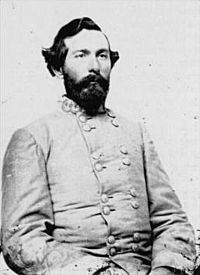George T. Anderson facts for kids
Quick facts for kids
George Thomas Anderson
|
|
|---|---|
 |
|
| Nickname(s) | "Tige" |
| Born | February 3, 1824 Covington, Georgia |
| Died | April 4, 1901 (aged 77) Anniston, Alabama |
| Place of burial |
Edgemont Cemetery
Anniston, Alabama |
| Allegiance | |
| Service/ |
|
| Years of service | 1847–1848; 1855–1858 (USA) 1861–1865 (CSA) |
| Rank | |
| Unit | Independent Company of Georgia Mounted Volunteers 1st U.S. Cavalry |
| Commands held | 11th Georgia Infantry Anderson's Brigade |
| Battles/wars | Mexican–American War American Civil War |
George Thomas Anderson (born February 3, 1824 – died April 4, 1901) was an important general in the Confederate States Army. This was during the American Civil War. People often called him "Tige." Anderson was known as one of Robert E. Lee's toughest and most determined commanders.
Early Life and Military Start
George Thomas Anderson was born in Covington, Georgia. He went to Emory University for a while. Later, he left to join the military. He served as a second lieutenant in the Georgia cavalry. Cavalry means soldiers who fight on horseback. This was during the Mexican–American War.
After that war, from 1848 to 1850, he became a major general in the Georgia Militia. A major general is a high-ranking officer. In 1855, he became a captain in the 1st U.S. Cavalry. But he left this position in 1858.
Fighting in the Civil War
When the American Civil War began, Anderson joined the Confederate Army. He became a colonel of the 11th Georgia Infantry regiment. A colonel is a senior officer who leads a large group of soldiers. He missed the First Battle of Bull Run because he arrived too late.
Anderson saw a lot of fighting during the war. He fought in the Peninsula Campaign at Yorktown. He also led a brigade during many major battles. A brigade is a large military unit, usually made of several regiments. These battles included the Seven Days Battles, Second Bull Run, Fox's Gap, Antietam, and Fredericksburg.
On November 1, 1862, he was promoted to brigadier general. This is a higher rank than colonel. Anderson missed the Chancellorsville. This was because his group of soldiers was operating in another part of Virginia.
Anderson's men rejoined the main Confederate army in time for the Gettysburg Campaign. He fought bravely at Devil's Den and the Wheatfield during the Battle of Gettysburg. He was wounded during this battle. He recovered in Charleston, South Carolina. He rejoined his soldiers later during the Siege of Knoxville.
In 1864, Anderson was involved in more intense battles. These included the Wilderness, Spotsylvania, Cold Harbor, and the operations around Richmond and Petersburg. He finally surrendered with General Lee at Appomattox Court House in April 1865. This marked the end of the Civil War.
Life After the War
After the Civil War ended, George Thomas Anderson started a new life. He worked as a railroad freight agent in Atlanta, Georgia. A freight agent helps manage goods transported by train. He also became the police chief in Atlanta.
Later, he moved to Anniston, Alabama. There, he continued his public service. He became the police chief in Anniston and also worked as a county tax collector. A tax collector helps gather taxes for the government.
George Thomas Anderson passed away in Anniston, Alabama, on April 4, 1901. He is buried in Edgemont Cemetery in Anniston.
See also

